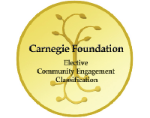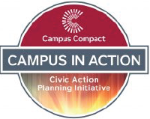CEL Examples
There are many ways to integrate community activities into a course. At Drake we emphasize project completion vs. hours accumulation and stress that it will be easier to design coursework if all students are involved in the community activity. Other considerations include the learning objectives, size of the class, the academic preparation of the students, and the community partnership or project type.
Project or Problem-Based
Project-based courses require students to work together in teams or as a whole class to produce and deliver a product for one or more community-based organizations. In this type of course students relate to the community as a “consultant” working for a “client.” Students gain knowledge and experience through course content that will allow them to help a community agency to answer questions or solve a problem. The project's deliverables are determined by the organization's client(s).
- Examples:
- Public Relations Capstone- students create a complete multimedia campaign for a local nonprofit client
- LEAD 100: Leadership Influence & Change- students learn about building effective teams and examine issues related to the leadership of organizations and communities by completing a project for a nonprofit organization.
Multiple course projects
CEL projects with one or more partners may span different courses in the same semester or multiple courses over a year or longer. These projects must be broad enough to meet the learning goals of multiple courses over time, and because of this, they may have a cumulative impact on both student learning and community development that is robust. Such projects may be particularly suited to course clusters or learning communities within or across disciplines, or course sequences, say, within a major, that build student capacity towards advanced learning and community action goals.
Placement-Based
Placement-based CEL courses require students to volunteer regularly with a community organization or project. Faculty, in consultation with CEL staff, will usually select a group of non-profit partners most appropriate for the course. Placement-based experiences enhance students' understanding of course content by asking them to volunteer directly in the community at an organization whose mission aligns with the course's academic outcomes.
- Examples:
- POLS 175: Human Trafficking-students volunteer 15-20 hours at local organizations focused on human trafficking education, awareness, and prevention.
Community Education and Advocacy
Community Education/Advocacy courses ask students to share course content with the broader community for purposes of informing them on issues and encouraging them to take action for personal or social change. Sometimes this involves students putting on events such as a health fair or a public symposium with the goal of disseminating important information and building networks of students, faculty, and community members to engage in further collaborative work. Other times, students create and publish materials (such as newspaper articles, magazines, web sites or electronic portfolios, videos, etc.) designed to make information more accessible to the general public.
- Examples
- LEAD 190: LEAD Capstone, students team with a non-profit or campus partner to define and implement a change initiative. Successful projects have included the Water Bottle Ban, Drake Bike Library, and starting the Drake Neighborhood Little Free Pantries.
- Development of Sprout: The Des Moines Urban Youth Learning Garden
Action research projects
This type of class involves students conducting research within the community. The results of the research are communicated to the agency so that it can be used to address community needs. Action research and participatory action research take a significant amount of time to build relationships of trust in the community and identify common research agendas; however, community research projects can support the ongoing research of faculty. Extending this type of research beyond the confines of a semester may be best for all involved.
- Examples
- JMC 143: PR Planning and Management-This course explores the role of strategic planning and issues management in public relations. Students work with a community partner to identify PR needs and create an action report with suggested areas of improvement, projects, and next steps.
One-time group service project
Some course objectives can be met when the entire class is involved in a one-time service project. Arrangements for service projects can be made prior to the semester and included in the syllabus. This model affords the opportunity for faculty and peer interaction because a common service experience is shared. One-time projects have different learning outcomes than ongoing service activities.
- Examples
- Pharmacy Orientation -As part of the first-year pharmacy orientation all P1’s complete a 3-hour service project with a local agency.
Service Internships
Service internships take place at a non-profit organization and include the use of an on-going reflection component. Unlike traditional internships, service internships involve a greater emphasis on reciprocity.
- Examples:
- Engaged Citizen Corps
- Writing Internship Program
Students can search for the CEL attribute in MyDusis to look for classes with a Community Engaged Learning component.









